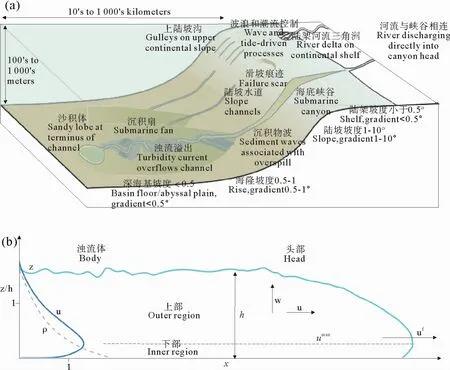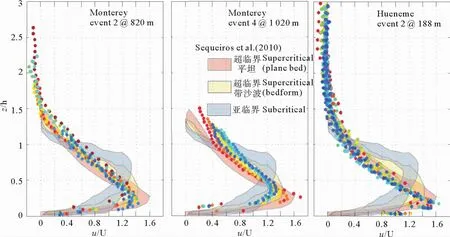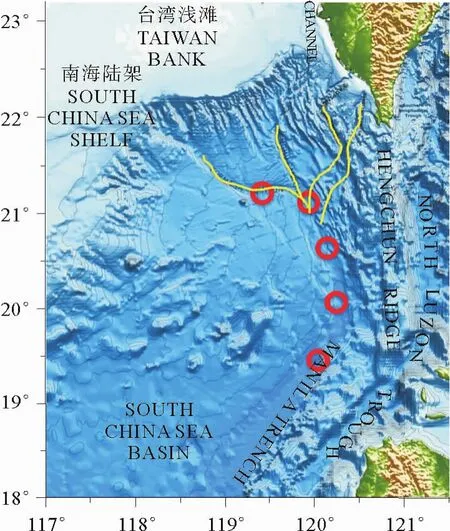海底浊流研究百年回顾
2014-06-24徐景平
徐景平
(1.中国海洋大学海洋地球科学学院;2.海洋科学与技术青岛协同创新中心,山东青岛266100)
海底浊流研究百年回顾
徐景平1,2
(1.中国海洋大学海洋地球科学学院;2.海洋科学与技术青岛协同创新中心,山东青岛266100)
本文概括性地回顾了一个多世纪以来浊流研究的历史和发展过程。浊流既是解决许多海洋地质学和沉积学基础科学问题的关键,又与海洋资、能源和海底灾害防护等应用性研究息息相关,多国科学家近百年的努力在浊流理论的发展、实验室水槽数据采集和数值模拟的优化等方面都有很大的进步。但由于浊流的不可预测性和破坏性,如何在现场实时、连续地对浊流实施观测至今仍然是浊流研究的瓶颈。南海东北部海域集天时、地利于一体,在此实施多学科浊流现场观测研究有望实现在‘破坏性’浊流的机制、过程、和沉积响应研究方面的突破。
浊流;现场观测;南海
2009年8月7 ~9日强台风莫拉克在台湾登陆,南台湾遭受持续暴雨袭击,大小河流洪水泛滥,其泥沙携带量也急剧增加,高屏溪临近入海处的悬沙浓度一度超过60 kg/m3[1],远远超出了形成河口异重流(Hyperpycnal flows)的临界条件(40 kg/m3)[2]。果然,随后就发生了台湾西南外海海底的多条通讯电缆有顺序地遭受不同程度破坏的事件,并且有充分证据显示这些电缆的有序破坏是浊流造成的[1]。比莫拉克浊流事件早三年的屏东大地震(2006年12月26日,M7.0),也导致浊流沿高屏峡谷高速移动并进入马尼拉海沟,沿途切断了数根国际通讯电缆[3]。不难看出,这两次浊流事件与80年前(1929年)发生在Grand Banks地震形成的浊流是多么的相似[4]。浊流研究不仅仅是一项重要的基础科学研究,同时也越来越与人类的日常生活息息相关。但是由于大型浊流的随机性和破坏性,科学家目前对此类破坏性浊流的认知在过去差不多一个世纪以来并没有显著的进步。本文旨在回顾一个世纪来海底浊流研究的主要发展,简述物理、数值模型和现场观测在非破坏性浊流研究中取得的重要成果,并对如何把这些成果应用到破坏性浊流的现场观测研究提出展望。
1 定义浊流
浊流(Turbidity Currents)是密度流(Density Currents)或重力流(Gravity Currents)的一种,其高密度来源于体内在湍流作用下的高悬砂浓度。浊流的名称是由Lamont的Johnson[5]首先在1939年提出的,在此之前,科学家曾经用的名字包括密度流[6]或悬浮颗粒流[7]。多数浊流源自陆坡(坡度大)或河口(沉积物快速堆积,故不稳定),不稳定沉积体在外力(如地震)作用下产生水下滑坡,滑坡体在朝深水移动的过程中与周围水体混合形成浊流(见图1)。浊流的传输距离一般远远大于初始滑坡体的运动距离,可达几百甚至上千公里,直达深海海盆。当浊流进入深海海盆,地形坡度减小,其速度随之降低,造成浊流体内的泥沙有序沉降,形成粒度向上变细的(graded)砂质浊积岩。浊积岩的名称是由荷兰地质学家Kuenen在1957年首先提出的[8]。此外,浊流也极大地影响了深海海盆生态环境。一方面浊流带来了大量的陆源营养盐,另一方面浊流也在其途经之地对底栖生物造成了破坏和掩埋。还有学者认为这些浊流与底栖生物之间的相互作用与在浊流沉积体内发现油气资源不无关系[9]。浊流是地球上大体积碎屑沉积物远距离搬运的最重要过程[10-11]。一次大型浊流的沉积物搬运量甚至超过了全球所有河流一年入海沉积物的总和[12]。几百万立方米的物质在短时间内被搬运到上百公里以外的深海盆地,形成富含地球上最大的沉积物堆积体-海底沉积扇,极易成为油气资源储集层。但是,浊流也是不可忽视的海洋地质灾害。浊流的强大破坏力对海底设施,如油气开采平台、海底通信电缆等形成直接的威胁。目前,几乎所有连接中国与全球的通信(电话、互联网、金融市场信息等)全部依靠海底电缆。2009年台湾南部地震触发的浊流切断了数根海底通信电缆,严重影响东南亚甚至全球通信达2个多月之久[1,3]。
2 浊流研究的前期工作
可查文献中最早涉及浊流的应该是Forel[13],在这篇短文里他描述了来自罗纳河(Rhone River)泥沙浓度很高的底流进入日内瓦湖(Lake Geneva)的情形。但在随后的半个世纪关于浊流的研究却鲜有发表。19世纪初大量海底峡谷(Submarine Canyons)和平坦的深海平原的发现[14-19]为海洋地质学家就如何解释这些自然现象提出了不小的挑战,但最终都由浊流成因做出了较为圆满的解答。Daly[6],Kuenen[20]和Bell[21]先后就浊流作为沉积物长距离搬运载体和其强大的冲刷能力从理论和试验角度发表了一系列研究成果。海洋地质学家们曾一直把海底浊流比作水下的河流[6]。正如地面河流在适当的地质和水文条件下在地质历史上将地球表面冲刷出许多深达千米的峡谷(如中国的长江三峡和美国的Grand Canyon),海底浊流因为其携带大量的粗/细颗粒沉积物而具有更强的冲刷力,在海底形成了许多陆源碎屑物质向深海输运的最佳通道-海底峡谷[6]。除了浊流的冲刷功能,它的输运和沉积功能也引起了科学家的关注[7]-浊流完全有能力把大量的陆源碎屑物质在陆坡和深海海盆重新分配。自1940年代开始,美国科学家对取自太平洋和大西洋深水平原的柱状样开始系统的分析工作[22],进一步加深了对浊流和浊流沉积的认识。Scripps的Shepard和Emory[23]首先认识到在美国太平洋沿岸的几条峡谷的上部时常发生突然的滑塌,并指出这些浅水区的滑塌将导致大量沉积物向深水区的输运,最终在洋底深处形成与之对应的砂层[24]。这些解释被后来来自San Diego海槽的柱状样分析结果一一证实[25]。Lamont的海洋地质学家Maurice Ewing的团队在大西洋深水柱状样里发现“干净”的砂层[26],彻底改变了以往对深海沉积学的认识和理解。在这些砂层里发现的浅水种有孔虫[26]成为其源自陆架浅水区的证据。Lamont海洋地质学家Bruce Heezen利用1929年Grand Banks地震所造成的电缆破坏尝试了对海底浊流流速的定量研究[27],并引发了针对Grand Banks的浊流流速是否能达到90 km/h的问题的不同观点的公开讨论[28-29]。在浊流沉积研究方面,Kuenen and Migliorini[30]的水槽试验工作被公认为浊流沉积学的经典,同前述的海上工作一起开辟了浊流研究的新篇章。

图1 (a)大陆边缘(包括陆架、陆坡和深海盆地)与浊流关系密切的地形地貌单元。(b)典型的浊流形状示意图和无量纲流速(u)和密度(γηο)垂直剖面。uf是浊流的锋面位移速度。原图来自Meiburg and Kneller(2010)。Fig.1 (a)Context of turbidity currents on the margins of continents and intracontinental basins,including deep lakes.(b)Schema of a turbidity current showing generalized velocity and density profiles.(from Meiburg and Kneller,2010)
关于浊流的研究不能不提到“鲍马层序,Bouma Sequence”[31]。鲍马层序是Arnold Bouma根据对法国Annot砂岩里多条露头岩层剖面总结的理想化地层层序,代表了浊流在减速过程中的理想沉积顺序。随着浊流流速的逐步减弱,先后形成以下4个沉积单元:Ta-快速沉积形成的正粒径层理中砂或粗砂层;Tb-沉积速率减小形成平行纹理发育的细、中砂层;Tc-爬升波纹理发育的细砂和粗粉砂层;Td-水动力最弱的浊流尾部沉积形成平行纹理的细粉砂和粘土层。这一理想化的沉积模型仅是一个对浊流沉积的简单总结,虽然在解释海底沉积扇浊流沉积体中得到较广泛的应用,但它并不具备系统地解释沉积和动力机理的能力,到目前为止还没有一个实验室浊流实验能够复制一个完整的鲍马层序[32-33]。随着对浊流的动力机制和沉积过程认识的深入,科学家也开始了对鲍马层序的修正和扩展[34-35]。
3 国际浊流研究进展
当科学家对浊流的产物(尤其是沉积产物turbidites)进行了较为系统的研究之后,浊流的形成机理和传输过程自然地成为他们下一个研究目标。对浊流的机理与过程的研究是1960年代开始的。1966年加拿大Mc Master大学的Middleton在其实验室做了一系列的水槽试验,针对密度流和浊流的共异性进行了非常细致的工作[36-39],与50年代的几个著名的浊流水槽试验[30]不同的是Middleton的试验更加量化(quantitative)。这些试验的一项重要成果是浊流的头部与盐水密度流有许多相似性,浊流头部运动的一些参数可以通过密度流的模拟试验[40]来获得。因为密度流的制作和试验要比浊流容易的多,这为以后的浊流室内试验研究提供了很多方便。在这期间,浊流研究学者已经基本形成一个共识,那就是海洋浊流大部分是由海底滑坡引起的块体流或碎屑流(debris flows)演变而成的,为此,Hampton[41]从理论和试验角度详细讨论了由滑坡(landslide)到块体流的演变以及由块状流到浊流的演变。该研究发现从块体流到浊流的演化主要是在块体流的头部发生的,沉积物在块体流头部锋面的剪切应力作用下被冲刷并抛至块体流的头部顶端的湍流区域,进而与周围水体混合形成浊流[41],作者由此推断这是海底浊流的主要形成机制。
浊流的另外一种主要成因是高悬砂浓度的异重流(hyperpycnal flows)入海或入湖后形成的。因为海水的密度要比湖水大,海洋环境里异重流的临界悬砂浓度也要高的多[2],也就是说在湖里更容易实地观测到浊流事件。事实上,浊流的第一批现场测量数据来自瑞士的瓦伦湖[42]和美国的五大湖之一的Lake Superior[43]。利用测流仪器连续数天观测流速和流向,Lambert等[42]发现:(1)瓦伦湖里测到的浊流最高流速达30 cm/s,且较高流速的浊流是以脉冲(pulsating)形式出现的。认为这些脉冲式的浊流信号与附近的Linth河的流量变化有直接关系;(2)浊流流速随时间变化呈不对称性,事件发生时流速迅速达到最高值,然后以类似指数(exponential)的形式缓慢递减。Normark和Dickson[43]观测到的浊流实属意外收获。他们的研究地点在当地一家铁燧岩矿尾处理水(tailing)排放口的附近,多年的尾水排放已经形成了一个水下三角洲,并且在较陡的三角洲前坡上有冲刷水道。由于他们在湖里布放的锚系并不是为研究浊流而设计的,因此两次锚系都布防在水道之外。尽管如此,在30个星期的连续观测期间,Normark和Dickson[43]记录到了大小不同的25次“人造浊流”事件。最大浊流流速接近30 cm/s,并且脉冲式的流速信号也相当普遍。与Lambert et al.[42]的脉冲信号不同的是,水下三角洲陡坡处间歇性的滑塌造成了脉冲式的浊流速度和厚度的变化。继1976年在瓦伦湖的前沿性观测工作以后,Lambert[44]又在界于德国、瑞士、和奥地利边界的博登湖(Lake Constance)进行了观测研究,并记录到了高达120 cm/s的浊流流速。稍后,Lambert and Giovanoli[45]在日内瓦湖(Lake Geneva)对100多年前Forel[13]在日内瓦湖浊流的先驱性工作进行了进一步验证。日本学者Kazuhisa Chikita[46]发表了在北海道一水库里的浊流观测工作。利用一部便携式流速计,作者对春天雪融水入库时沿河道的垂向与横向的流速、流向、温度和沉积物浓度剖面做了非常细致的观测记录,并对浊流的三维动力特征进行了分析。尽管其最高流速只有15 cm/s左右,但得出了之前诸多项观测研究未能取得的结果:(1)库底的水温(密度)随水深减小(增加),入库浊流因此出现了分层现象,即比重高的浊流底部继续沿库底流动,而比重较低的浊流上部由于其密度在达到一定深度时变得小于当地的底层水密度而离开库底变成interflows。(2)弯曲的水道对浊流有相当明显的离心(centrifugal)作用。
如前所述,海底浊流多由海底滑坡进一步演变而成。由于形成机制的不可预测性,海底浊流的观测研究要比湖底浊流的观测研究困难许多。到目前为止还没有任何仪器能经受像1929年Grand Banks浊流冲击而不被破坏,因此海底浊流的现场观测主要是针对低速浊流,而且此类工作大部分是在海底峡谷里进行的。Shepard等[47]和Inman等[48]分别描述了在La Jolla海底峡谷里的海流观测资料,并将所观测到的脉冲式低速度浊流与暴风雨天气和与之相关的近岸海浪情况联系起来。Dengler等[49]在夏威夷瓦胡岛外海的观测数据包括在飓风(hurricane)Iwa期间4次浊流事件,其最大浊流流速可达200 cm/s,并伴随着海底水温的明显参加。作者进而推测这4次浊流极有可能是飓风造成的陆架或陆坡上部海底滑坡所引起的。二十世纪最系统的现场浊流研究(包括过程和产物)当数加拿大和美国学者在Bute Inlet的工作[50-51]。Bute Inlet是一个典型的冰川地形-峡湾,它的源头连接两条小河的河口。浊流在河口水下三角洲形成后携带大量沉积物沿峡湾底部向深水处运动,因此在湾底形成了70多公里长的类似沉积扇的浊流沉积体[51],该研究除了沿峡湾布放了3套锚系记录浊流的速度、厚度等特征参数外,还通过地球物理方法和柱状取样对峡湾的海底地形和沉积物分布进行了较为详细的调查。结果显示从1986年5月至9月底有9次大小浊流发生,最大厚度30多米,最大海流计测量速度110 cm/s,但是由浊流抵达3个站位锚系的时间推算出来的速度却高达330 cm/s。另外根据海底地形[52]和底质沉积物粒度[53]推算的浊流速度还要更高(160~450 cm/s)。此外,根据柱状样内不同浊积层序(turbidites)的粒度信息,推断出过去曾经发生过流速超过500 cm/s的浊流事件。
自1980年代开始,浊流的实验室研究和数值模拟进入了一个蓬勃发展的黄金时期,并发表了一大批优秀的研究成果。在实验室物理模型研究方面以Gary Parker(先在University of Minnesota,后去了University of Illinois与Marcelo Garcia合作)的团队最为突出。利用其完备的实验室物理模拟设备,在浊流的发生、运动过程及其变化、以及最后的沉积等实验研究上做了大量工作[54-60],并以此为基础,推动了浊流理论的发展[61-62]和浊流数值模型的进步[63-67]。在欧洲,英
国[68-72]和荷兰[73-74]科学家也做了许多细致的实验工作,而后者更以浊流造成的地形地貌为主要研究对象。随着浊流理论的发展和实验数据的大量积累与消化,用数值方法(numerical methods)模拟浊流的能力也有了很大的提升,由一维的简单模型[75-77]到二维的流速和浓度垂直剖面[78]到三维、多参数的数值模拟[67,79,80]。但是,要解决大自然环境复杂海洋浊流问题,仅有实验室数据和各种复杂程度的解析或数值模型是不够的,从自然环境里获取现场实测数据也就成为浊流研究的关键一环。到目前为止,美国地质调查局(USGS)和MBARI(Monterey Bay Aquarium Research Institute)在Monterey海底峡谷的浊流观测资料仍然是相对最完整的现场数据[81]。采用将ADCP倒挂的方法,从2002年12月~2003年11月在Monterey海底峡谷的3个站位布放潜标,连续观测捕捉到了4次浊流事件,有史以来首次实地观测得到了高精度的浊流流速剖面[82]。这些实测的流速剖面数据对深入研究浊流的一些无量纲参数,如最大流速与垂直平均流速的比值等提供了权威性的界定(图2)[83]。同样重要的是3个潜标上近底部的沉积物捕获器成功地收集了几次浊流过程中的悬浮物样品,这些首次从浊流“体内”获得的样品为进一步研究浊流的动力学性质和沉积过程[60,84-85]提供了宝贵的第一手资料。同样的观测方法后来在其它海底峡谷也得以应用并取得了良好结果[86-88]。

图2 实验室浊流测量数据(彩色阴影区)与海底峡谷实测浊流数据(彩色点)的对比Fig.2 Normalized velocity profiles from field and laboratory measurements
4 我国浊流研究现状与展望
海洋浊流研究是目前公认的地球科学研究中最具挑战性的课题之一。与地球上另外一个主要沉积物搬运过程-河流相比,科学家对浊流仍然所知甚少。浊流大多发生在深水区,现场观测研究成本与风险均很大;浊流发生的不可预见性,要求长期连续观测;浊流的破坏性,很多观测仪器非坏即失。自从1929年发生著名的Grand Bank浊流事件[27]以来,科学家在湖泊和海底峡谷积累了不少流速慢、浓度低的小型浊流的资料[89,82-90],但对大型浊流的认知仅有3例:Var峡谷[77],Zaire沉积扇[91],和台湾西南的峡谷/马尼拉海沟[3],而且这些仅有的资料还主要是依靠通信电缆的断裂顺序和钻孔样品分析。因此,开展‘破坏性’浊流的现场观测研究已经成为国际地学领域的研究热点。2013年在意大利召开的浊流工作会议规划了未来5-10年浊流研究的路线图,并确定了包括Monterey峡谷和马尼拉海沟等6个研究实验场(test sites)。英国的NERC(The Natural Environment Research Council)率先资助了2015—2018年由英国(National Oceanographic Center)、美国(Monterey Bay Aquarium Research Institute,U.S.Geological Survey)、和中国(中国海洋大学)科学家联合在Monterey峡谷的大型观测研究计划。
我国在浊流领域的研究工作开展相对较晚。但过去30年我国地球和海洋科学的发展和积累为开展深海浊流研究打下了坚实的基础。借助我国海洋石油工业丰富的钻孔、2-D和3-D地震和地球物理资料以及数年来基金委的项目资助,我国科学家在南海,尤其是鹦哥海和西北次海盆,做了大量的研究工作并取得了丰硕的成果[92-95]。这些地层序列和古海底地貌变迁的研究成果为现代浊流过程的研究工作提供了坚实的基础,但正如许多学者直接或间接地指出[96-99],缺乏对重力流/浊流的实地观测工作以及其形成和搬运机制的研究是这一领域亟待解决的问题。开展系统的浊流研究,为海底资源开发和海洋地质灾害防御提供科学和技术支撑已是当务之急。
南海的马尼拉海沟是观测研究现代大型浊流的最佳地点。南海北部的几条主要海底峡谷(高屏、枋寮、福尔摩沙)全部在吕宋海峡西部汇聚后连接马尼拉海沟的北端(见图3)。每年平均4次台风给台湾岛上带来的强降雨加上岛上高坡度河流造成非常高的泥沙侵蚀[100],2009年莫拉克台风更是刷新了72 h内降雨量的世界纪录。这些都是形成浊流的良好初始和边界条件。南海北部频繁的地震活动是激发大型浊流的主要因素。2006年屏东地震造成的浊流在马尼拉海沟流经300多公里并切断14根通信电缆[3]。这些都是能在较短时间内观测到大型浊流事件的有利条件。第一次由我国科学家主导的深海钻探IODP 349航次见证了两百万年以来在动荡的南海深部频发的浊流产物-浊积岩(http://mgg.tongji.edu.cn/school/index.php?option= com_content&view=article&id=824)。珍贵的资料和样品也无情地将一系列的科学问题摆在了我们面前:浊流输运的巨量沉积物质来自何方?泥沙在经过上百/千公里的输运过程后为什么在这里沉积下来?那时的南海深部为何如此动荡?对南海浊流发生机制和输运过程进行深入研究将是能否回答这些科学问题的关键。

图3 南海东北部海底地形。黄色曲线代表几条海底峡谷的位置。沿马尼拉海沟走向的红色圆圈示意观测仪器的布放位置Fig.3 Bottom topography of the northeastern South China Sea.The yellow lines trace the several canyons in the area;circles in red indicate proposed sampling sites along the Manila Trench
致谢:感谢中国海洋大学学报的约稿,谨以此短文祝贺中国海洋大学90华诞!
[1] Carter L,Milliman J D,Talling P J,et al.Near-synchronous and delayed initiation of long run-out submarine sediment flows from a record-breaking river flood,offshore Taiwan[J].Geophysical Research Letters,2012:39(12).doi:10.1029/2012GL051172.
[2] Mulder T,Syvitski J P,Migeon S,et al.Marine hyperpycnal flows:initiation,behavior and related deposits[J].A Review Jmpg,2003,20(6):861-882.
[3] Hsu S K,J Kuo,C L Lo,et al.Sibuet,Turbidity currents,submarine landslides and the 2006 Pingtung earthquake off SW Taiwan[J].Terr Atmos Oceanic Sci,2008,19:767-772.doi:10.3319/TAO.
[4] Piper D J W,SHOR A N,Hughes Clarke J E.The 1929“Grand Banks”earthquake,slump,and turbidity current[J].Geological Society of America,1988,229:77-92.doi:10.1130/SPE229-p77.
[5] Johnson D W.The origin of submarine canyons.Columbia Univ[M].New York:Press,1939.
[6] Daly R A.Origin of submarine canyons[J].Amer J Sci 5th Ser,1936,31:401-420.
[7] Stetson H C,Smith J F.Behavior of suspension currents and mud slides on the continental slope[J].Am J Sci,1938,35:1-13.
[8] Kuenen Ph H.Sole markings of graded graywacke beds[J].JGeol,1957,65:231-258.
[9] Schneeberger F.Turbidity Currents on a new concept in sedimentation and its application to oil exploration[J].The Mines Magazine,1995(10):42-62.
[10] Walker R G.Deep-water sandstone facies and ancient submarine fans:Models for exploration for stratigraphic traps[J].American Association of Petroleum Geology Bulletin,1978,62:932-966.
[11] Pirmez C,Imran J.Reconstruction of turbidity currents in Amazon Channel[J].Marine and Petroleum Geology,2003,20:823-849.
[12] Talling P,Amy L,Wynn R,et al.Evolution of turbidity currents deduced from extensive thin turbidites:Marnoso Arenacea Formation(Miocene),Italian Apennines[J].Journal of Sedimentary Research,2007,77:172-196.doi:10.2110/jsr.2007. 018.
[13] Forel F A.Les ravins sous-lacustre des fleuves glaciaires[J].C R Acad Sci Paris,1885,101:725-728.
[14] Spencer JW.Submarine valleys off the American coast and in the North Atlantic[J].Bull Geol Sac Am,1903,14:201-226.
[15] Shepard F P.Submarine valleys[J].Geogr Rev,1933,23:77-89.
[16] Shepard F P.Canyons off the New England coast[J].Am JSci,1934,27:2436.
[17] Shepard F P.Continued exploration of California submarine canyons[J].Trans Am Geophys Union,1936,1:221-223.
[18] Ewing M.Exploring the Mid-Atlantic Ridge[J].Natl Geogr Mag,1948,94:275-294.
[19] Ewing M.New discoveries on the Mid-Atlantic Ridge[J].Natl Geogr Mag,1949,95:611-640.
[20] Kuenen P H.Experiments in connection with Daly's hypotheses on the formation of submarine canyons[J].Leidsche Geol Meded,1937,8:327-335.
[21] Bell H S.Density currents as agents for transporting sediments[J].J Geol,1942,50:512-587.
[22] Horn D,Ewing J.Graded-bed Sequences Emplaced by Turbidity Currents North of 20°N in the Pacific,Atlantic and Mediterranean-horn-2006-Sedimentology-Wiley Online Library[J].Sedimentology,1972.
[23] Shepard F P,Emery K O.Submarine topography off the California coast:canyons and tectonic interpretation[J].Geol SOC Am Spec Pap,1941,31:171.
[24] Shepard F P.Transportation of sand into deep water.Turbidity Currents and the Transportation of Course Sediments to Deep Waters,a Symposium-Soc.Econ.Paleontol.[s.l.]:Mineral,Spec Publ,1995a,2:53-65.
[25] Ludwick J C.Deep Water Sand Layers off San Diego,California[M].La Jolla,Calif:Thesis,Scripps Inst.of Oceanography,1950:55.
[26] Cricson D B,Ening M,Heezen B.Turbidiry currents and sediment in the North Atlantic.AAPC Bulletin,1952,36:489-511.
[27] Heezen B C,Ewing W M.Turbidity currents and submarine slumps and the 1929 Grand Banks(Newfoundland)earthquake[J].American Journal of Science,1952,250:849-873.doi:10. 2475/ajs.250.12.849.
[28] Shepard F.High-Velocity Turbidity Currents,a Discussion[C]. Proceedings of the Royal Society of London.Series A,1954.
[29] Heezen B,Ericson D.Further evidence for a turbidity current following the 1929 Grand Banks earthquake[J].Deep Sea Research,1953.
[30] Kuenen P H,Migliorini C.Turbidity currents as a cause of graded bedding[J].The Journal of Geology,1950:91-127.
[31] Bouma A H.Sedimentology of Some Flysch Deposits:a Graphic Approach to Facies Interpretation[M].Amsterdam:Elsevier,1962:168.
[32] Shanmugam G.The Bouma Sequence and the turbidite mind set[J].Earth-Science Reviews,1997,42:201-229.
[33] Shanmugam G.Ten turbidite myths[J].Earth Science Reviews,2000,58(3-4):311-341.
[34] Lowe D R.Sediment gravity flows:2.Depositional models with special reference to the deposits of high-density turbidity currents[J].Journal of Sedimentary Petrology,1982,52:279-297.
[35] Kneler B.Beyond the turbidite paradigm:physical models for deposition of turbitites and their implication for reservoir prediction[M].∥Hartley A,Prosser D J.Characterisation of Deep Marine Clastic Systems.London:Geological Society of London,1996:29-46.
[36] Middleton G.Small-scale models of turbidity currents and the criterion for auto-suspension[J].Journal of Sedimentary Research,1996a.
[37] Middleton G.Experiments on density and turbidity currents:I. Motion of the head[J].Canadian Journal of Earth Sciences,1996b.
[38] Middleton G.Experiments on density and turbidity currents:II. Uniform flow of density currents[J].Canadian Journal of Earth Sciences,1996c.
[39] Middleton G.Experiments on density and turbidity currents.III. Deposition of sediment[J].Can J Earth Sci,1967.
[40] Keulegan G H.Twelfth progress report on model laws for density currents[M].∥The Motion of Saline Fronts in Still Water.U S Natl Bur:Standards Rept,5831.
[41] Hampton M.The role of subaqueous debris flow in generating turbidity currents[J].Journal of Sedimentary Petrology,1972,42(4):775-793.
[42] Lambert A,Kelts K,Marshall N F.Measurements of density underflows from Walensee,Switzerland[J].Sedimentology,1976,23:87-105.
[43] Normark W.Man-made turbidity currents in Lake Superior[J]. Sedimentology,1976.
[44] Lambert A.Trubestrome des Rheins im Bodensee[J].Wasserwirtschaft,1982,72:169-172.
[45] Lambert A,Giovanoli F.Records of riverborne turbidity currents and indications of slope failures in the Rhone delta of Lake Geneva[J].Limnology and Oceanography,1988:458-468.
[46] Chikita K.A field study on turbidity currents initiated from spring runoffs[J].Water Resour.Res,1989:25(2),257-271.
[47] Shepard F P,Marshall N F,Mc Loughlin P A.Pulsating turbidity currents with relationship to high swell and high tides[J].Nature,1975,258:704-706
[48] Inman D,Nordstrom C,Flick R E.Currents in submarine canyons:An air-sea-land interaction.Annual Review of Fluid Mechanics,2007:275-310.
[49] Dengler A,Wilde P,Noda E.Turbidity currents generated by Hurricane Iwa[J].Geo-Marine Letters,1984.
[50] Prior D B,B D Bornhold,W JWiseman Jr,et al.Turbidity current activity in a British Columbia fjord[J].Science,1987,237:1330-1333.
[51] Zeng J,Lowe D R,Prior D,et al.Flow properties of turbidity currents in Bute Inlet,British Columbia[J].Sedimentology,1991,38(6):975-996.
[52] Komar P D.The channelized flow of turbidity currents with application to Monterey deep-sea fan channel[J].J Geophys Res,1969,74:4544-4548.
[53] Komar PD.The hydraulic interpretation of turbi-dites from their grain sizes and sedimentary structures[J].Sedimentology,1985,32:395407.
[54] García M H.Hydraulic jumps in sediment-driven bottom currents[J].J Hydraul Eng,1993,119(10):1094-1117
[55] García M H.Depositional turbidity currents laden with poorlysorted sedi-ment[J].J Hydraul Eng,1994,120(11):1240-1263.
[56] García M H,Parker G.Experiments on the entrainment of sediment into suspension by a dense bottom current[J].J Geophys Res[Oceans],1993,98(C3):4793-4807.
[57] Garcia M H,Parsons J D.Mixing at the front of gravity currents[J].Dyn Atmos Oceans,1996,24:197-205.
[58] Sequeiros O E.Estimating turbidity current conditions from channel mor-phology:a Froude number approach[J].JGeophys Res,2012,117(C4),http://dx.doi.org/10.1029/2011JC007201.
[59] Sequeiros O E,Naruse H,Endo N,et al.Experimental study on selfaccelerating turbidity currents[J].J Geophysical Res,2009,114(C5),C05025,http://dx.doi.org/10.1029/2008JC005149.
[60] Sequeiros O E,Spinewine B,Beaubouef R T,et al.Characteristics of velocity and excess density profiles of saline under-flows and turbidity currents flowing over a mobile bed[J].J Hydraul Eng,2010,136(7):412-433.
[61] Parker G.Conditions for the ignition of catastrophically erosive turbidity currents[J].Mar Geol,1982:46(3-4):307-327.
[62] Parker G,Fukushima Y,Pantin H M.Self-accelerating turbidity currents[J].J Fluid Mech,1986,171:145-181,http://dx.doi. org/10.1017/S0022112086001404.
[63] Zeng J,Lowe D.Numerical simulation of turbidity current flow and sedimentation:I.Theory[J].Sedimentology,1997.
[64] Huang H,Imran J,Pirmez C.Numerical Model of Turbidity Currents with a Deforming Bottom Boundary[J].Journal of Hydraulic Engineering,2005,131(4):283-293.doi:10.1061/(ASCE)0733-9429(2005)131:4(283).
[65] Huang H,Imran J,Pirmez C.Numerical modeling of poorly sorted depositional turbidity currents[J].Journal of Geophysical Research,2007,112:1-15.
[66] Kostic S,Parker G.The response of turbidity currents to a canyon-fan transition:internal hydraulic jumps and depositional signatures[J].Journal of Hydraulic Research,2006,44(5):631-653.doi:10.1080/00221686.2006.9521713.
[67] Abd El-Gawad S,Cantelli A,Pirmez C,et al.Three-dimensional numerical simulation of turbidity currents in a submarine channel on the seafloor of the Niger Delta slope[J].Journal of Geophysical Research,2012 117(C5).doi:10.1029/2011JC007538.
[68] Baas J,Van Dam R,Storms,J.Duration of deposition from decelerating high-density turbidity currents[J].Sedimentary Geology,2000,136(1):71-88.
[69] Baas J H,McCaffrey W D,Haughton P D,et al.Coupling between suspended sediment distribution and turbulence structure in a laboratory turbidity current[J].Journal of Geophysical Research,2005,110(C11):C11015.
[70] Baas J H,Manica R,Puhl E,et al.Processes and products of turbidity currents entering soft muddy substrates[J].Geology,2014,42(5):371-374.doi:10.1130/G35296.1.
[71] Felix M.Flow structure of turbidity currents[J].Sedimentology,2002,49(3):397-419.
[72] Choux C,Baas J,McCaffrey W,et al.Comparison of spatio-temporal evolution of experimental particulate gravity flows at two different initial concentrations,based on velocity,grain size and density data[J].Sedimentary Geology,2005,179(1):49-69.
[73] Postma G,Cartigny M,Kleverlaan K.Structureless,coarse-tail graded Bouma Ta formed by internal hydraulic jump of the turbidity current?[J].Sedimentary Geology,2009,219(1-4):1-6. doi:10.1016/j.sedgeo.2009.05.018.
[74] Cartigny M J B,Eggenhuisen J T,Hansen E W M,et al.Concentration-Dependent Flow Stratification In Experimental High-Density Turbidity Currents and Their Relevance To Turbidite Facies Models[J].Journal of Sedimentary Research,2014,83(12):1046-1064.doi:10.2110/jsr.2013.71.
[75] Bowen A J,Normark W R,Piper DJ.Modelling of turbidity currents on Navy submarine fan,California continental borderland[J].Sedimentology,1984,31:169-185.
[76] Skene K,Mulder T,Syvitski J.INFLO1:a model predicting the behaviour of turbidity currents generated at river mouths[J]. Computers and Geosciences,1997,23(9):975-991.
[77] Mulder T,Savoye B,Syvitski J.Numerical modelling of a midsized gravity flow:the 1979 Nice turbidity current(dynamics,processes,sediment budget and seafloor impact)[J].Sedimentology,1997,44(2):305-326.
[78] Stacey M W,Bowen A J.The vertical stcucture of turbitidy cuments and a necessary condition for self-maintenance.Journal of Geophysical Research,1988,93(4):3543-3553.
[79] Salles T,Mulder T,Gaudin M,et al.Simulating the 1999 Capbreton canyon turbidity current with a Cellular Automata model[J].Geomorphology,2008.
[80] Nasr-Azadani M M,Hall B,Meiburg E.Polydisperse turbidity currents propagating over complex topography Comparison of experimental and depth-resolved simulation results[J].Computers and Geosciences,2013,53(C):141-153.doi:10.1016/j.cageo. 2011.08.030.
[81] Meiburg E,Kneller B.Turbidity currents and their deposits[J]. Ann Rev Fluid Mech,2010,42:135-156.http://dx.doi.org/10.1146/annurev-fluid-121108-145618.
[82] Xu J,Noble M,Rosenfeld L.In-situ measurements of velocity structure within turbidity currents[J].Geophys Res Lett,2004,31(9):L09311.
[83] Xu J P.Normalized velocity profiles of field-measured turbidity currents.v[J].Geology,2010,38(6):563-566.http://dx. doi.org/10.1130/G30582.1.
[84] Pittaluga M B,Imran J.A simple model for vertical profiles of velocity and suspended sediment concentration in straight and curved submarine channels[J].Journal of Geophysical Research,2014.doi:10.1002/2013JF002812
[85] Xu J P,Sequeiros O E,Noble M A.Sediment concentrations,flow conditions,and downstream evolution of two turbidity currents,Monterey Canyon,USA.Deep-Sea Research,2014,89:11-34.
[86] Cooper C,Andrieux O.Turbidity current measurements in the Congo Canyon.OTC 23992[C].Houston:Offshore Technology Conference,2012:12.
[87] Khripounoff A,Crassous P,Bue Lo N,et al.Different types of sediment gravity flows detected in the Var submarine canyon(north-western Mediterranean Sea)[J].Prog.Oceanogr.2012:106(C):138-153.http://dx.doi.org/10.1016/j.pocean. 2012.09.0 01.
[88] Xu JP,Barry J P,Paull C K.Small-scale turbidity currents in a big submarine canyon[J].Geology,2013,41(2):143-146.http://dx.doi.org/10.1130/G33727.1.
[89] Normark W R.Observed pacaneters for turbidity-curnent flow in chamels,Reserve Fan,Lake Superios[J].Journal of Sedimentary Petrology,1989,59:423-431.
[90] Girardclos S,Schmidt O,Sturm M,et al.The 1996 AD delta collapse and large turbidite in Lake Brienz[J].Marine Geology,2007,241:137-154.
[91] Khripounoff A,Vangriesheim A,Babonneau N,et al.Direct observation of intense turbidity current activity in the Zaire submarine valley at 4000 m water depth[J].Mar Geol,2003,194(3-4):151-158.
[92] Gong C,Wang Y,Zhu W,et al.The Central Submarine Canyon in the Qiongdongnan Basin,northwestern South China Sea:architecture,sequence stratigraphy,and depositional processes[J]. Marine and Petroleum Geology,2011,28(9):1690-1702.
[93] 李磊,王英民,徐强,等.南海北部陆坡地震地貌及深水重力流沉积过程主控因素[J].中国科学:地球科学,2012,42(10):1533-1543.
[94] Chen H,Xie X,Van Rooij D,et al.Depositional characteristics and spatial distribution of deep-water sedimentary systems on the northwestern middle-lower slope of the Northwest Sub-Basin,South China Sea[J].Marine Geophysical Researches,2013,34(3-4):239-257.doi:10.1007/s11001-013-9191-7.
[95] Ding W,Li J,Li J,et al.Morphotectonics and evolutionary controls on the Pearl River Canyon system,South China Sea[J]. Marine Geophysical Researches,2013,34(3-4):221-238.doi:10.1007/s11001-013-9173-9.
[96] 钟广法,李前裕,郝沪军,等.深水沉积物波及其在南海研究之现状[J].地球科学进展,2007,22(9):907-913.
[97] Su M,Xie X.Gravity Flow on Slope and Abyssal Systems in the Qiongdongnan Basin,Northern South China Sea[J].Acta Geologica Sinica,2011,85(1):243-253.
[98] 李云,郑荣才,朱国金,等.珠江口盆地白云凹陷珠江组深水牵引流沉积特征及其地质意义[J].海洋学报,2012,34(1):128-135.
[99] 庞雄,柳保军,颜承志,等.关于南海北部深水重力流沉积问题的讨论[J].海洋学报,2012,34(3):114-119.
[100] Dadson S,Hovius N,Pegg S,et al.Hyperpycnal river flows from an active mountain belt[J].J.Geophys.Res.,2007,110,F04016.doi:10.1029/2004JF000244.
Turbidity Current Research in the Past Century:An Overview
XU Jingping1,2
(1.College of Marine Geosciences,Ocean University of China,Qingdao 266100,China;2.Qingdao Collaborative Innovation Center of Marine Science and Technology,Qingdao 266100,China)
This short paper briefly reviews the history of turbidity currents research in the past century.Turbidity currents hold the key to many fundamental questions in the fields of marine geology and sedimentology.Knowledge of turbidity currents’cause and destructive nature has direct application in marine hazard mitigation,deep-water resource development,and hydrocarbon energy industry.Tremendous strides have been made through many researchers’pioneering work in turbidity current theories,laboratory experiments,as well as numerical simulations.But because of its unpredictability and destructive nature,being able to continuously monitor field turbidity currents in-situ has yet been accomplished.Northeastern South China Sea is arguably the best site for such monitoring studies on large field,destructive turbidity currents.
Turbidity Currents;in-situ measurements;South China Sea
P736.2
A
1672-5174(2014)10-098-08
责任编辑 徐 环
2014-09-08;
2014-09-25
徐景平(1963-),男,教授。E-mail:xujp@ouc.edu.cn
